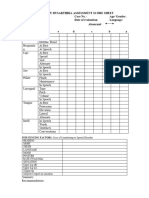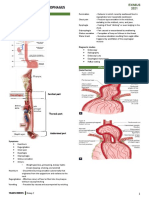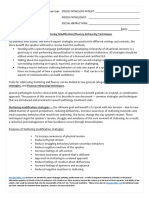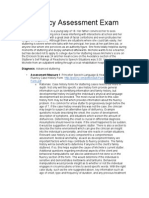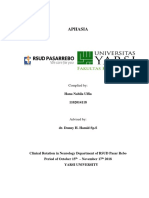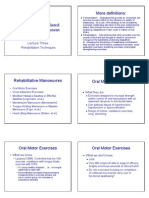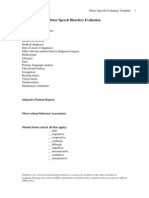Professional Documents
Culture Documents
Dysarthria
Dysarthria
Uploaded by
Banjo VergaraOriginal Description:
Copyright
Available Formats
Share this document
Did you find this document useful?
Is this content inappropriate?
Report this DocumentCopyright:
Available Formats
Dysarthria
Dysarthria
Uploaded by
Banjo VergaraCopyright:
Available Formats
What is slurred speech?
Slurred speech is a symptom characterized by poor pronunciation of words, mumbling, or a change in speed or rhythm during talking. The medical term for slurred speech is dysarthria. Dysarthria is a motor speech disorder. The muscles of the mouth, face, and respiratory system may become weak, move slowly, or not move at all after a stroke or other brain injurySlurred speech may develop slowly over time or follow a single incident. Slurred speech may be temporary or permanent, depending on the underlying cause.
What causes slurred speech?
There are many causes of slurred speech. Disease or injury to the brain or nerves and muscles of the face, tongue, and vocal cords may cause slurred speech.
y y y y y
Brain tumor Stroke Transient ischemic attack (temporary stroke-like symptoms that may be a warning sign of an impending stroke) Trauma to the face, head or neck Traumatic brain injury
What are some signs or symptoms of slurred speech?
A person with dysarthria may experience any of the following symptoms, depending on the extent and location of damage to the nervous system:
y y y y y y y y y y
Speaking softly or barely able to whisper Slow rate of speech Rapid rate of speech with a "mumbling" quality Limited tongue, lip, and jaw movement Abnormal intonation (rhythm) when speaking Changes in vocal quality ("nasal" speech or sounding "stuffy") Hoarseness Breathiness Drooling or poor control of saliva Chewing and swallowing difficulty
Possible Goals of Treatment
y y y y
Slowing the rate of speech Improving the breath support so the person can speak more loudly Strengthening muscles Increasing mouth, tongue, and lip movement
y y y
Improving articulation so that speech is more clear Teaching caregivers, family members, and teachers strategies to better communicate with the person with dysarthria In severe cases, learning to use alternative means of communication (e.g., simple gestures, alphabet boards, or electronic or computer-based equipment)
What can I do to communicate better with a person with dysarthria? It is important for both the person with dysarthria and the people he or she communicates with to work together to improve interactions. Here are some tips for both speaker and listener. Tips for the Person With Dysarthria
y y y y y
Introduce your topic with a single word or short phrase before beginning to speak in more complete sentences Check with the listeners to make sure that they understand you Speak slowly and loudly; pause frequently Try to limit conversations when you feel tired, when your speech will be harder to understand If you become frustrated, try to use other methods, such as pointing or gesturing, to get your message across, or take a rest and try again later
Children may need additional help to remember to use these strategies. Tips for the Listener
y y y y y y
Reduce distractions and background noise Pay attention to the speaker Watch the person as he or she talks Let the speaker know when you have difficulty understanding him or her Repeat only the part of the message that you understood so that the speaker does not have to repeat the entire message If you still don't understand the message, ask yes/no questions or have the speaker write his or her message to you
http://www.asha.org/public/speech/disorders/dysarthria.htm
You might also like
- DOSSDocument1 pageDOSSKathie-Lee PetschNo ratings yet
- Franchay Dysarthria Assessment Score SheetDocument2 pagesFranchay Dysarthria Assessment Score SheetStarmarkKamikaze100% (1)
- PmvbedsideevaluationDocument2 pagesPmvbedsideevaluationapi-114739487No ratings yet
- Swallow Screening ToolDocument1 pageSwallow Screening Toolidris Lajide100% (1)
- SP Patienthandout AphasicpatientDocument1 pageSP Patienthandout Aphasicpatientapi-11473948750% (2)
- SLP Case StudyDocument8 pagesSLP Case StudyMaria Fernanda Leiva ArguelloNo ratings yet
- Aphasia Treatment Project PortfolioDocument9 pagesAphasia Treatment Project Portfolioapi-314413672No ratings yet
- Natalie Brickner-Slp ResumeDocument1 pageNatalie Brickner-Slp Resumeapi-238387904No ratings yet
- Dukes Exercise Program Sheets 2Document17 pagesDukes Exercise Program Sheets 2Tiffani Wallace100% (1)
- Treatment of Wernicke'S Aphasia With Jargon: A Case StudyDocument11 pagesTreatment of Wernicke'S Aphasia With Jargon: A Case StudyIvanaNo ratings yet
- Dysarthria and Dysphonia Neuro1Document7 pagesDysarthria and Dysphonia Neuro1Ersya MuslihNo ratings yet
- Apraxia of Speech in AdultsDocument11 pagesApraxia of Speech in AdultsMitali SharmaNo ratings yet
- Dysphagia NotesDocument5 pagesDysphagia Notesapi-31372205650% (2)
- Post Stroke WritingDocument9 pagesPost Stroke WritingAdi ParamarthaNo ratings yet
- Diseases of Esophagus.Document3 pagesDiseases of Esophagus.Isabel Castillo100% (2)
- ORLADocument10 pagesORLACarol CoelhoNo ratings yet
- Dysphagia in The Elderly (Marco Teoìrico)Document12 pagesDysphagia in The Elderly (Marco Teoìrico)Nutriologo Luis Garcia CampechanoNo ratings yet
- Global AphasiaDocument5 pagesGlobal AphasiaMuhammad Agus NurNo ratings yet
- Dysarthria ChartDocument12 pagesDysarthria ChartTalia Garcia100% (1)
- Adductor Spasmodic Dysphonia: A Case For Speech and Language TherapyDocument3 pagesAdductor Spasmodic Dysphonia: A Case For Speech and Language TherapySpeech & Language Therapy in PracticeNo ratings yet
- Assessment and Treatment of Linguistic Deficits PDFDocument96 pagesAssessment and Treatment of Linguistic Deficits PDFJumraini TammasseNo ratings yet
- Cilt HandoutDocument4 pagesCilt Handoutapi-454269640No ratings yet
- Aca - 1Document28 pagesAca - 1Aparna LVNo ratings yet
- MedSLPCollective Handout Vocal Function ExercisesDocument8 pagesMedSLPCollective Handout Vocal Function ExercisesFenti FentikaNo ratings yet
- Classification of Velopharyngeal DysfunctionDocument1 pageClassification of Velopharyngeal DysfunctionVictoria Rojas AlvearNo ratings yet
- Bedside Evaluation of Dysphagia: Rafia MubeenDocument41 pagesBedside Evaluation of Dysphagia: Rafia Mubeenaleeza nomanNo ratings yet
- Prevention Program BrochureDocument2 pagesPrevention Program Brochureapi-232834696No ratings yet
- IDDSI Framework Testing Methods 2.0 - 2019Document14 pagesIDDSI Framework Testing Methods 2.0 - 2019MayraNo ratings yet
- Applications of ICF in Language DisordersDocument27 pagesApplications of ICF in Language DisordersGowher NazirNo ratings yet
- Normal Non - Fluency, Primary Stuttering and Secondary StutteringDocument21 pagesNormal Non - Fluency, Primary Stuttering and Secondary StutteringK PNo ratings yet
- Effective SLPDocument10 pagesEffective SLPRené Ignacio Guzmán SalgadoNo ratings yet
- Psychological Aspects of Dysphagia PresentationDocument28 pagesPsychological Aspects of Dysphagia Presentationjenmae2028No ratings yet
- 2014mshahandouts StoeckelDocument37 pages2014mshahandouts StoeckelAna Vogeley100% (1)
- Mbs De-IdentifiedDocument2 pagesMbs De-Identifiedapi-645942287No ratings yet
- Session 2 9Document15 pagesSession 2 9Ersya Muslih0% (1)
- Apraxia of Speech CharacteristicsDocument2 pagesApraxia of Speech CharacteristicsJoseph AngelloNo ratings yet
- Articulation and Phonological Processess SummarisedDocument2 pagesArticulation and Phonological Processess SummarisedSuné GreeffNo ratings yet
- HANDOUT ABLE Summary of Stuttering ModificationFluency Enhancing TechniquesDocument4 pagesHANDOUT ABLE Summary of Stuttering ModificationFluency Enhancing TechniquesBrianna WongNo ratings yet
- 1326 Yorkston Kathryn PDFDocument70 pages1326 Yorkston Kathryn PDFArunprasad DurairajNo ratings yet
- Therapy Techniques For StutteringDocument3 pagesTherapy Techniques For StutteringSherin ManojNo ratings yet
- Voice Assessment ProceduresDocument7 pagesVoice Assessment ProceduressplijaNo ratings yet
- Nkosi Sharpe Assessment MSD 08Document9 pagesNkosi Sharpe Assessment MSD 08Paula QuezadaNo ratings yet
- Broca Aphasia Sign Symptom2020Document23 pagesBroca Aphasia Sign Symptom2020aleeza nomanNo ratings yet
- Parent Questionnaire (Speech)Document4 pagesParent Questionnaire (Speech)Khairul Zainizah KhairudinNo ratings yet
- Quick Articulation PDFDocument12 pagesQuick Articulation PDFGénesis Contreras MellaNo ratings yet
- Dysphagia PDFDocument6 pagesDysphagia PDFPavel LeahuNo ratings yet
- Fluency Assessment ExamDocument18 pagesFluency Assessment Examapi-294798019No ratings yet
- Aphasia: Hana Nabila Ulfia 1102014118Document14 pagesAphasia: Hana Nabila Ulfia 1102014118hana nabilaNo ratings yet
- Childhood Apraxia of SpeechDocument11 pagesChildhood Apraxia of SpeechRoshniNo ratings yet
- Dysphagia & Related Disorder ManagementDocument12 pagesDysphagia & Related Disorder ManagementVedashri14100% (1)
- Sample Treatment PlanDocument3 pagesSample Treatment PlanLiza NaumannNo ratings yet
- A at Motor SpeechDocument5 pagesA at Motor SpeechNini JohannaNo ratings yet
- Clinical Review: Dysarthria, HypokineticDocument19 pagesClinical Review: Dysarthria, HypokineticRashid HussainNo ratings yet
- Dysphagia Handicap Index, Development and ValidationDocument7 pagesDysphagia Handicap Index, Development and ValidationWlf OoNo ratings yet
- Apraxia TXDocument20 pagesApraxia TXadriricaldeNo ratings yet
- How - . - I Train Others in Dysphagia.Document5 pagesHow - . - I Train Others in Dysphagia.Speech & Language Therapy in PracticeNo ratings yet
- The RainbowpassageDocument1 pageThe Rainbowpassageapi-114739487No ratings yet
- Aphasia Short Term Goals Long Term Goals Evaluation Assessment WriteUpDocument4 pagesAphasia Short Term Goals Long Term Goals Evaluation Assessment WriteUpTarienNo ratings yet

